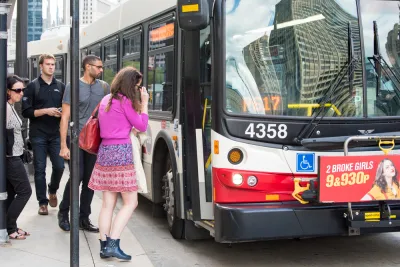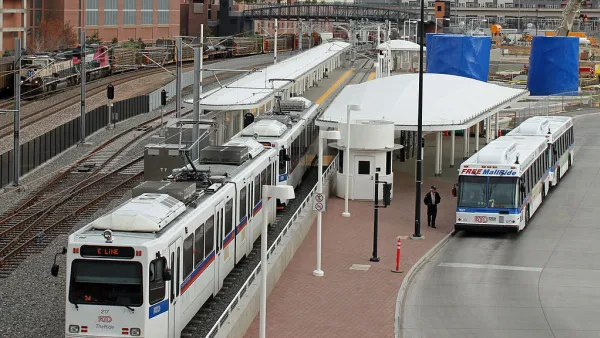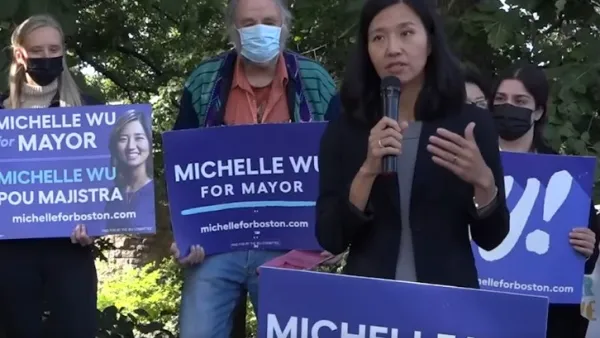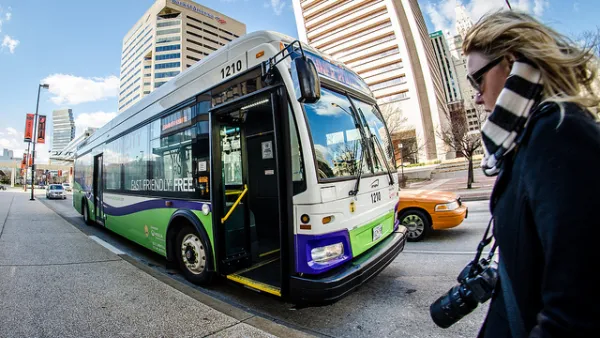Despite a preference among policymakers for high-tech transit solutions, the humble bus, with the right infrastructure and funding, has the potential to be the heart of a comprehensive, reliable, and cost-effective transit system.

"Buses are hard to love," writes Farhad Manjoo in the New York Times, but with over 4.6 billion trips made by bus per year, they're really the workhorses of the American public transit system. Despite a growing focus on high-tech solutions like autonomous vehicles and high-speed rail, Manjoo argues, investing in buses can make a big, almost-immediate impact on the experience of transit riders. "With the proper investment, city buses might be transformed into the sort of next-generation transportation service that technology companies and car companies have spent billions over the last decade trying to build — a cheap, accessible, comfortable, sustainable, reliable way to get around town."
According to Manjoo, "all we’ve got to do is buy more buses, hire more bus drivers and, in some places, give buses special privileges on the road. All we’ve got to do is care enough to build bus systems that work." When given priority on roads, buses can be the faster, more convenient option than private cars or even subways. London's transit system provides one example of an effective bus network. What makes London's bus system work so well, writes Manjoo, is scale: "there are simply enough buses in London to allow for frequent, reliable service to the parts of the city that people want to travel to."
But despite their advantages, bus transit doesn't see a lot of support in policy circles. Simply put, "bus riders wield little political or economic clout; a disproportionate number are people with low incomes." Yet bus transit is cheap and efficient. According to the Urban Institute, "for about $17 billion annually, every American city with at least 100,000 people could more than double its transit capacity."
FULL STORY: We Need Buses, Buses Everywhere

Analysis: Cybertruck Fatality Rate Far Exceeds That of Ford Pinto
The Tesla Cybertruck was recalled seven times last year.

National Parks Layoffs Will Cause Communities to Lose Billions
Thousands of essential park workers were laid off this week, just before the busy spring break season.

Retro-silient?: America’s First “Eco-burb,” The Woodlands Turns 50
A master-planned community north of Houston offers lessons on green infrastructure and resilient design, but falls short of its founder’s lofty affordability and walkability goals.

Test News Post 1
This is a summary

Analysis: Cybertruck Fatality Rate Far Exceeds That of Ford Pinto
The Tesla Cybertruck was recalled seven times last year.

Test News Headline 46
Test for the image on the front page.
Urban Design for Planners 1: Software Tools
This six-course series explores essential urban design concepts using open source software and equips planners with the tools they need to participate fully in the urban design process.
Planning for Universal Design
Learn the tools for implementing Universal Design in planning regulations.
EMC Planning Group, Inc.
Planetizen
Planetizen
Mpact (formerly Rail~Volution)
Great Falls Development Authority, Inc.
HUDs Office of Policy Development and Research
NYU Wagner Graduate School of Public Service




























